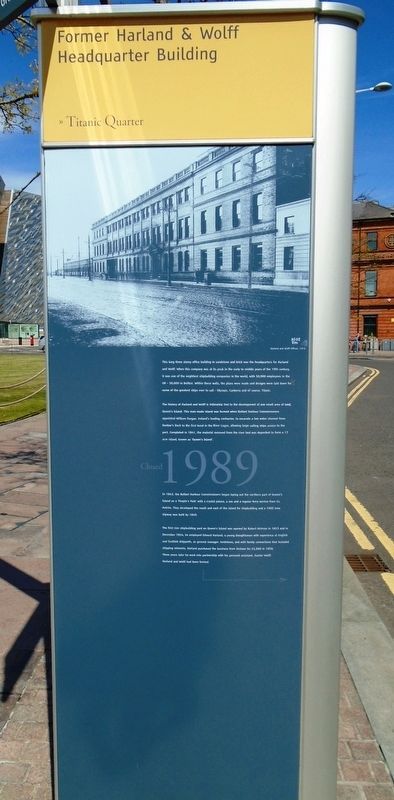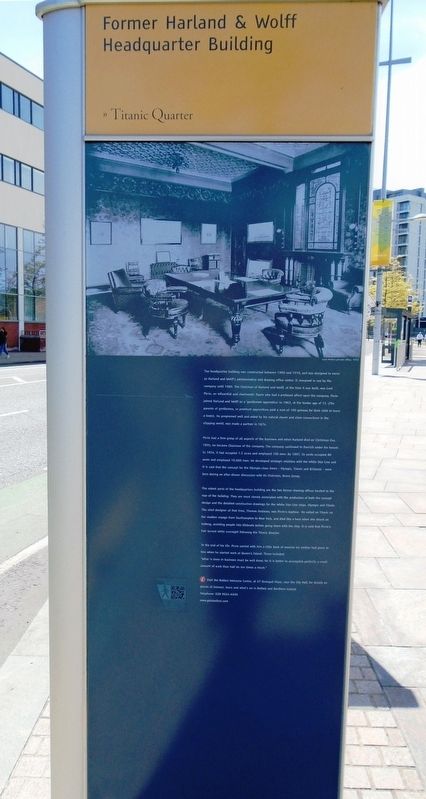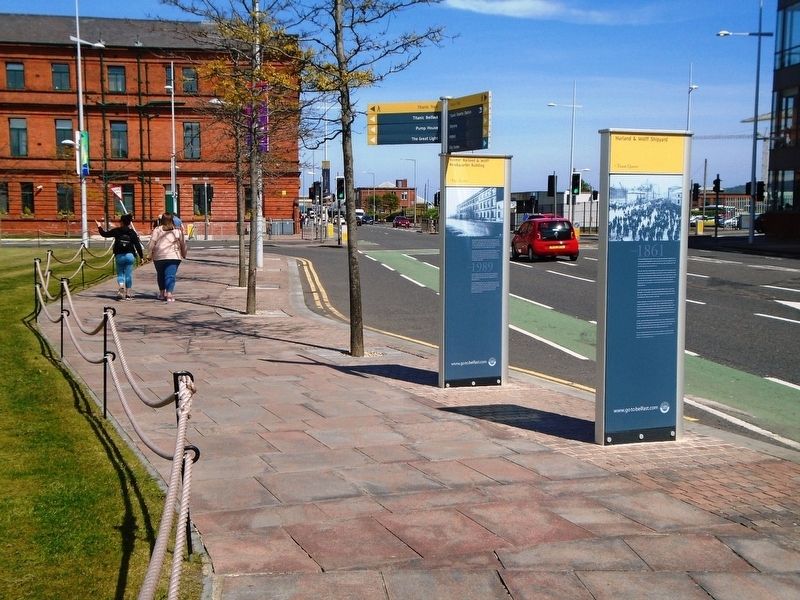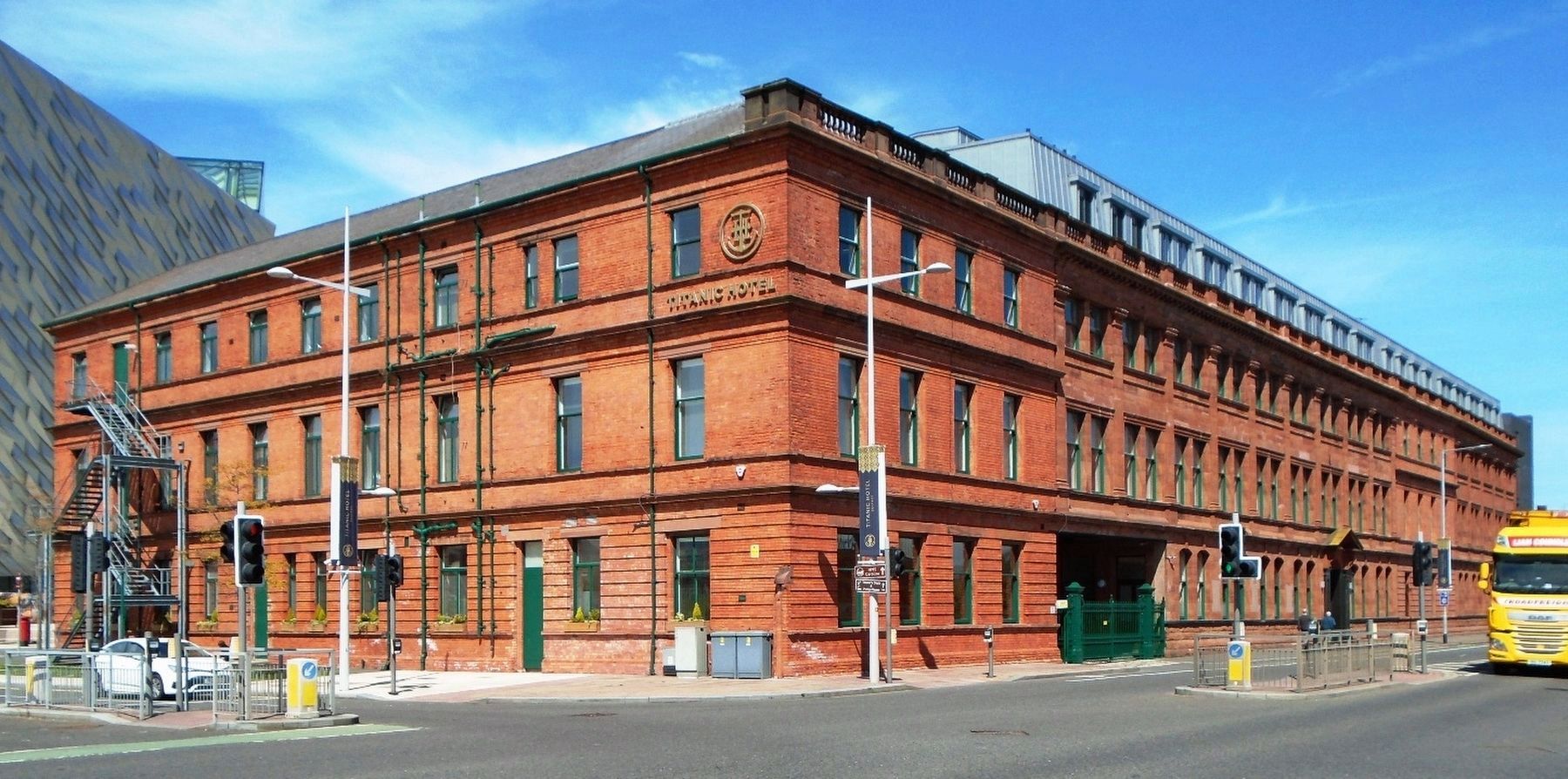Belfast, Northern Ireland, United Kingdom — Northwestern Europe (the British Isles)
Former Harland & Wolff Headquarter Building
Closed 1989
— Titanic Quarter —
Inscription.
This long three storey office building in sandstone and brick was the headquarters for Harland and Wolff. When this company was at its peak in the early to middle years of the 19th [sic - 20th] century, it was one of the mightiest shipbuilding companies in the world, with 50,000 employees in the UK - 30,000 in Belfast. Within these walls, the plans were made and designs were laid down for some of the greatest ships ever to sail - Olympic, Canberra and of course, Titanic.
The history of Harland and Wolff is intimately tied to the development of one small area of land, Queen's Island. This man-made island was formed when Belfast Harbour Commissioners appointed William Dargan, Ireland's leading contractor, to excavate a low water channel from Dunbar's Dock to the first bend in the River Lagan, allowing large sailing ships access to the port. Completed in 1841, the material removed from the river bed was deposited to form a 17 acre island, known as 'Queen's Island'.
In 1843, the Belfast Harbour Commissioners began laying out the northern part of Queen's Island as a 'People's Park' with a crystal palace, a zoo and regular ferry service from Co. Antrim. They developed the south and east of the island for shipbuilding and a 1000 tons slipway was built in 1849.
The first iron shipbuilding yard on Queen's Island was opened by Robert Hickson in 1853 and in December 1854, he employed Edward Harland, a young draughtsman with experience at English and Scottish shipyards, as general manager. Ambitious, and with family connections that included shipping interests, Harland purchased the business from Hickson for £5,000 in 1858. Three years later he went into partnership with his personal assistant, Gustav Wolff. Harland and Wolff had been formed.
[Photo caption reads]
Harland and Wolff Offices, 1912
[Back]
The headquarter building was constructed between 1900 and 1919, and was designed to serve as Harland and Wolff's administrative and drawing office centre. It remained in use by the company until 1989. The Chairman of Harland and Wolff, at the time it was built, was Lord Pirrie, an influential and charismatic figure who had a profound affect upon the company. Pirrie joined Harland and Wolff as a 'gentleman apprentice' in 1862, at the tender age of 15. (The parents of gentlemen, or premium apprentices paid a sum of 100 guineas for their child to learn a trade). He progressed well and aided by his natural charm and close connections in the shipping world, was made a partner in 1874.
Pirrie had a firm grasp of all aspects of the business and when Harland died on Christmas Eve, 1895, he became Chairman of the company. The company continued to
flourish under his tenure. In 1854, it had occupied 1.5 acres and employed 100 men. By 1897, its yards occupied 80 acres and employed 10,000 men. He developed strategic relations with the White Star Line and it is said that the concept for the Olympic-class liners - Olympic, Titanic and Britannic - were born during an after-dinner discussion with its Chairman, Bruce Ismay.
The oldest parts of the headquarters building are the two former drawing offices located at the rear of the building. They are most closely associated with the production of both the concept design and the detailed construction drawings for the White Star Line ships, Olympic and Titanic. The chief designer at that time, Thomas Andrews, was Pirrie's nephew. He sailed on Titanic on her maiden voyage from Southampton to New York, and died like a hero when she struck an iceberg, assisting people into lifeboats before going down with the ship. It is said that Pirrie's hair turned white overnight following the Titanic disaster.
To the end of his life, Pirrie carried with him a little book of maxims his mother had given to him when he started work at Queen's Island. These included:
"What is done in business must be well done; for it is better to accomplish perfectly a small amount of work than half do ten times a[s] much."
[Photo caption reads]
Lord Pirrie's private office, 1912
Erected by the City of Belfast.
Topics. This historical marker is listed in these topic lists: Industry & Commerce • Waterways & Vessels. A significant historical year for this entry is 1841.
Location. 54° 36.414′ N, 5° 54.584′ W. Marker is in Belfast, Northern Ireland. Marker is on Queens Road just north of Bell's Theorem Crescent, on the left when traveling north. Touch for map. Marker is in this post office area: Belfast, Northern Ireland BT3 9DT, United Kingdom. Touch for directions.
Other nearby markers. At least 8 other markers are within walking distance of this marker. Harland and Wolff Shipyard (here, next to this marker); Caisson (within shouting distance of this marker); The Bridge Deck (about 90 meters away, measured in a direct line); First Port: Views of Belfast (about 90 meters away); 1908 Harland and Wolff Shipyard (about 90 meters away); Shipbuilding & Mapmaking [Part 2] (about 90 meters away); On Board SS Nomadic (about 90 meters away); Hamilton Dock: Refurbishment and Restoration (about 90 meters away). Touch for a list and map of all markers in Belfast.
Also see . . .
1. Drawing Offices History at Titanic Hotel. (Submitted on June 19, 2019, by William Fischer, Jr. of Scranton, Pennsylvania.)
2. Harland and Wolff at Wikipedia. (Submitted on June 19, 2019, by William Fischer, Jr. of Scranton, Pennsylvania.)
Credits. This page was last revised on September 7, 2022. It was originally submitted on June 19, 2019, by William Fischer, Jr. of Scranton, Pennsylvania. This page has been viewed 204 times since then and 21 times this year. Photos: 1, 2, 3, 4. submitted on June 19, 2019, by William Fischer, Jr. of Scranton, Pennsylvania.



